The last Saturday in June, we went on a day trip to Fort Concho in San Angelo, about four hours northwest of Austin, to celebrate my birthday. Concho is one of a string of frontier forts established in the 1850s and 1860s to fight the Indians; it’s one of the most completely preserved and reconstructed too. Nearly all the extant Texas frontier forts are reconstructed, because after the Army abandoned them all in the 1870s and 1880s and locals mercilessly scavenged the stone buildings for building materials, while the flimsy frame structures fell down in just a few years through being built of green wood. In the case of Concho, which is owned by the city of San Angelo, most of the stone buildings around the parade ground were restored or rebuilt from the 1920s to the 1960s, including enlisted men’s barracks, armory buildings, the base hospital, the commandant’s HQ, and officers’ quarters.
Instead of going up Texas 71 through Oak Hill, which is perfectly awful for suburban traffic and a hundred traffic lights, L had us go out US 183 to pick up Texas 29 at Seward Junction, thirty miles north, and go through Liberty Hill, Bertram, and Burnet to get to Llano. We stopped in Burnet so M could look at the courhouse—she’s got bit with the same courthouse bug the rest of my family has—and found a little bitty farmer’s market on the square, where we bought a loaf of pecan bread and some homemade jam. We all decided that Burnet’s courthouse is dull; it’s not much more than a bunch of pink granite blocks stuck together with a few Art Deco details to it. So we took our bread and jam and went on up 29 to Llano. When we got there, L said why didn’t we go on west to Mason on 29 instead of going up 71 direct to Brady because Mason is kinda pretty, so we did that. And Mason was really pretty when we got there. It has a very nice courthouse from 1910, which of course we couldn’t see the inside of because it was Saturday (although I did go shake the door because you never know), the old firehouse on the courthouse grounds which is now the P.D. and DPS headquarters instead, and the jail, which was built in 1894 from local sandstone and is still in operation because nobody is willing to vote the bonds to build a new one. Why the state jail standards commission hasn’t closed them down before now I don’t know; I learned later that they have 17 separate variances from the commission in order to continue operating.
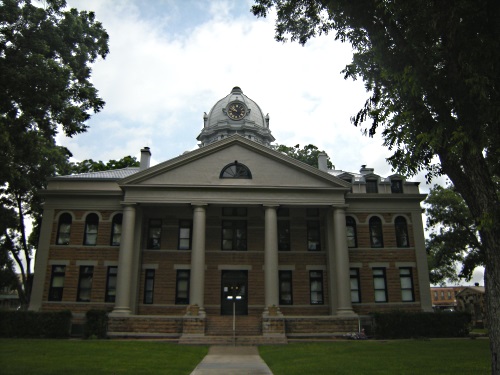
South side of the Mason County courthouse. The battering effect is because it’s built on a slope and you have to shoot uphill.
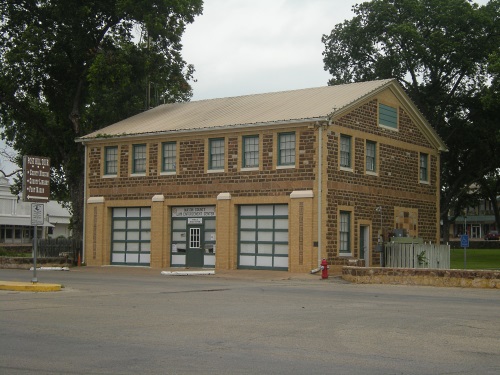
The old Mason firehouse, now the Law Enforcement Center, which means the police, sheriff, and DPS share an office. The fire whistle is still in place on its tower at one side, but not visible ’cos it’s tangled up in a pecan tree.
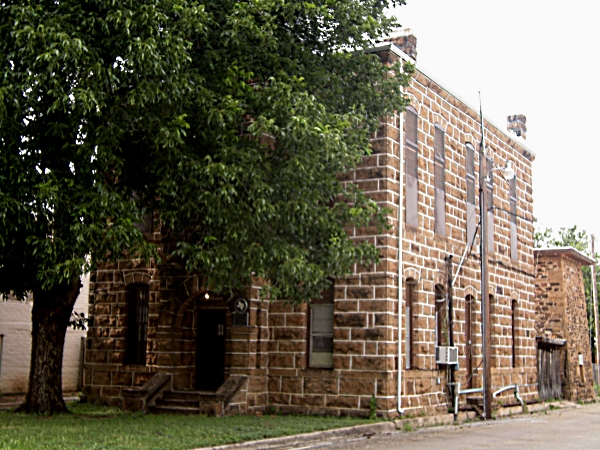
The antique that is the 1894 Mason County jail. Somebody understood that a jail ought to look like a cage, not an office park.
Right next to the jail was a sign pointing down the street to the library, and L wanted to go look at what they had, so we drove down there. It’s in the city park, across the street from an abandoned icehouse, and they have a very nice building, from the outside anyway. We couldn’t go in because they don’t open Saturdays, but outside they had a statue of Old Yeller and either Travis or Arliss (I can’t tell which—probably Travis), which is the centerpiece of a fundraising engraved-brick plaza. Of course, I was completely unsurprised by the statue because the author, Fred Gipson, was born and raised in Mason. M took pictures of the statue and the icehouse ruins, and we got back on the road and went to Brady.
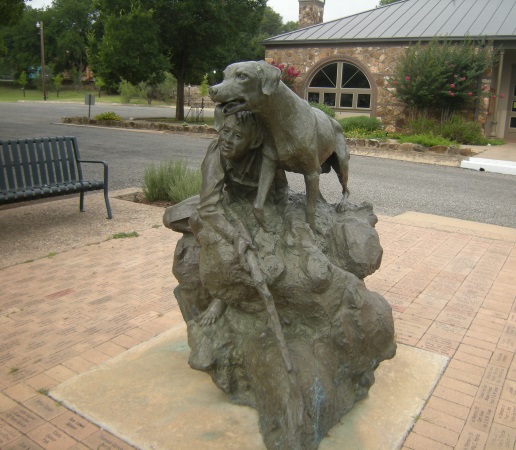
Old Yeller and his boy, in front of the Mason library.
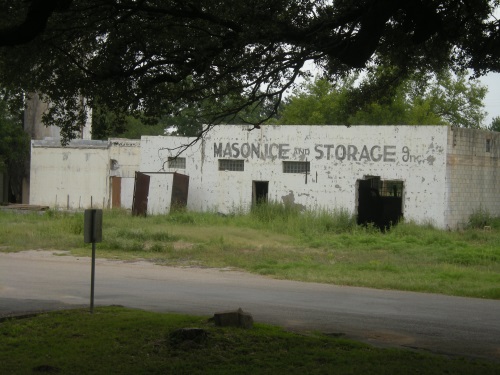
Ruins of the icehouse and cold-storage plant. This was a fairly common combination, since you had all that extra cold just going to waste otherwise.
At Brady we stopped to let M take pictures of that courthouse, and we also stopped to look at the old McCulloch County jail, which is red brick but has a tower and crenellations and all sorts. It’s now owned by the county historical society. They weren’t open on Saturday either, but we looked through the fence. It didn’t take long to look at that horseshoe, and we started up US 87 to Angelo.
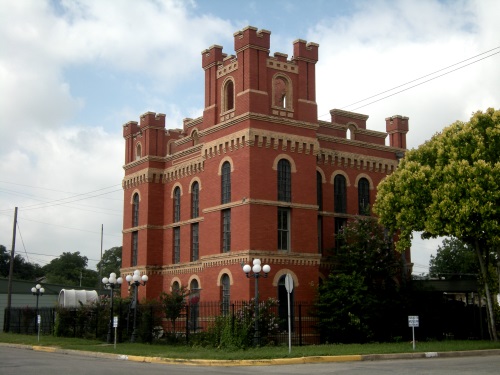
The old jail at Brady. If you can’t make the jail look like a cage, at least make it look like a castle. Dungeon optional.
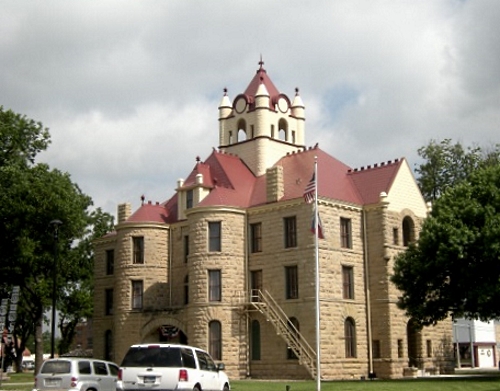
The McCulloch County courthouse at Brady. Although the tower has roundels as though they were going to install a clock, the building never had one and there’s no other evidence they really did mean to put a clock in.
There isn’t a lot to see on US 87 except a lot of hopper trucks which seem to be hauling drilling mud and oilfield chemicals, and there were plenty of them. Eden, at 2,700 people the largest town in Concho County (but still not the county seat), wasn’t interesting except for one pretty little 1930s motor court which somebody seems to be taking care of; all the paint was fresh and there weren’t any weeds in the driveways.
We got to the fort right at noon, paid our admission and started walking around the parade ground. M was taken by a display of period firearms in the visitor’s center—another bug she has, this one gotten after going to the firearms collection at Panhandle-Plains Museum in Canyon last year on our trip to San Francisco. Further on down the north side, we got into a talk with the docent for the field artillery, a very knowledgeable man who talked about the merits of the different guns the fort had at the time, and explained why field artillery was such an expensive proposition (a battery of six guns required sixty or seventy men and nearly as many horses to support it).
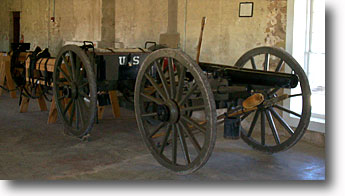
The three-inch artillery rifle and its caisson. It shot either a twelve-pound ball or canister shot, with a range of 1800 yards. Photo ©2009 Fort Concho National Historic Landmark.

M was taken by the grim humor in this sign, posted when the artillery is practicing. Even taking blast and wadding in the face and chest will do you major damage. Duck.
After the artillery, we walked over to look at the modern stables for the re-enactment program, of which the fort has an extensive one. All the horses were outdoors in the pens, but the stables were also home to a good-sized chuck wagon, which I imagine sees use during re-enactment days, and a perfectly gorgeous replica of a Concord-style coach in Wells Fargo livery, which was nonetheless wildly out of place. Number one, Wells Fargo wasn’t running in the Concho Valley region at that time; Charles Bain operated the stage line running from San Antonio to Fort Concho. Second, nobody used Concord coaches in this area because (a) they were too attractive a target for Indians, and (b) they were too fragile to hold up under the kind of rough use they would get. Instead, stage operators used “celerity wagons,” open, canvas-topped coaches pulled by a team of mules, which the Indians looked down on and wouldn’t try to steal as they would horses.
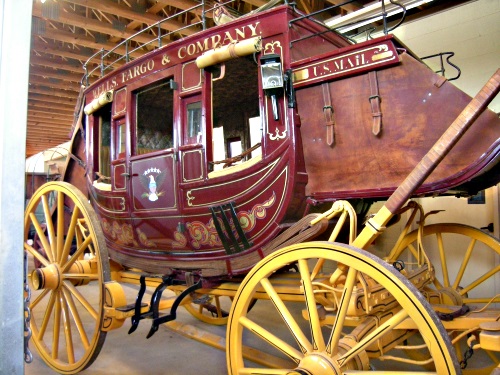
The coach was sure pretty, though. A brass plate on the side of the driver’s seat told that it had been built by a company in Weatherford, which I didn’t know could support a coachmaker.
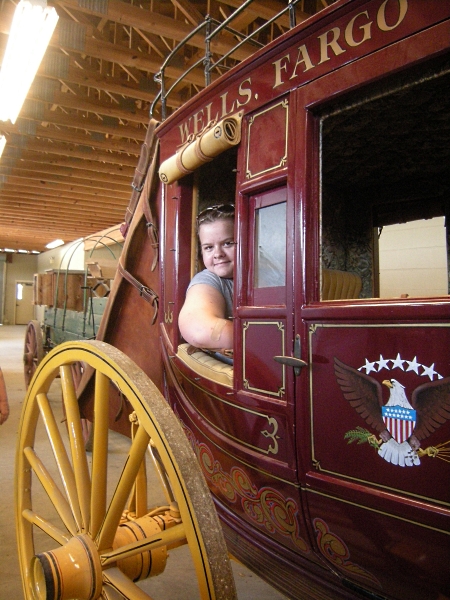
M posed in the Concord coach, which was open for picture-taking.
The Fort Concho re-enactment program is especially notable because Fort Concho was one of the places that African-American troops were stationed, the well-known Buffalo Soldiers. The 10th Cavalry spent the years 1875 to 1882 at the fort, and chased and fought the Kiowa, Comanche, Apache and others. Many Black re-enactors drive great distances to participate in fort events. If we had come a week later, we could have seen them in action around the Independence Day celebration, but I wasn’t willing to put up with such a crowd as they would draw, in the heat. Maybe one year at Christmas.
We looked in on one of the cavalry barracks, the Commandant’s house, the hospital, and the schoolroom. All of them are reconstructions to one extent or another, as the originals mostly either fell down or burned; the Commandant’s house is the only one that’s unequivocally intact, because it was acquired for use as a museum in 1928. The reconstructions are all beautifully done, though, and historically justifiable as accurate. The museum has done the hard work.

The reconstructed post hospital, complete with wide porches and belvedere on top for improved ventilation and airflow. Photo ©2009 Fort Concho National Historic Landmark.
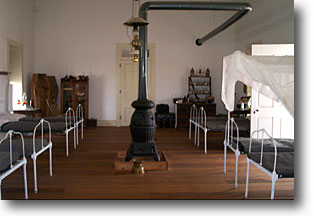
Ward in the north wing, capable of housing about eight beds. Photo ©2009 Fort Concho National Historic Landmark.
The hospital is on the far southeast corner of the post, and shares its grounds with a modern-day elementary school. Appropriately, the first building you come to after rounding the corner is the fort’s old chapel/school building, completed in 1879. It’s presented in its schoolroom configuration, with engravings on the wall of presidents Washington and Lincoln (expected) and Grant (not quite as expected; he finished his second term in 1876).
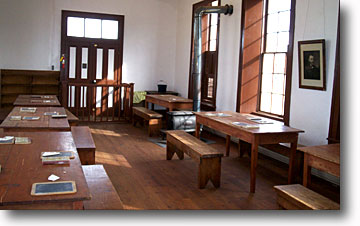
The post school room, as it might have been about 1880. Photo ©2009 Fort Concho National Historic Landmark.
Officers’ Row comprises the south side of the parade ground; there are nine houses, one of which is a ruin—on purpose. Quarters 5 was used as a private residence for many years and not well maintained, and by the time the fort got their hands on it, it was too unstable to do anything with, so they decided to tear it down until it looked like something you would see at Fort Griffin, to show the period masonry construction techniques used.
An unexpected thing we found was a telephony museum in Quarters 4, funded by Verizon and full of equipment donated by General Telephone & Electric (Verizon’s predecessor) and Verizon employees. It was full of everything from Swedish and Danish wall phones from 1905 to Telex machines and part of a railroad-side telegraph pole and insulators. L and I both wished for my brother Chris, who used to work for Southwestern Bell, to be there because he would have got a lot more from it.
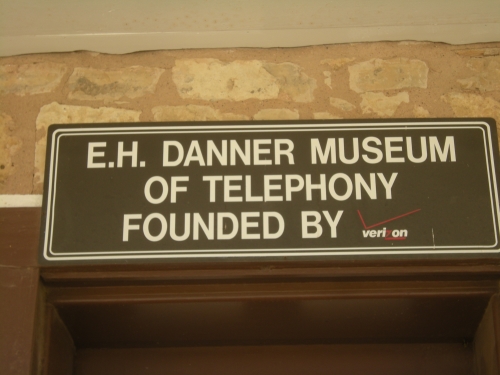
Sign announcing the telephony museum.
At that point it was about two o’clock and I was getting light-headed from low blood sugar, so we had to pass up looking at the nearby Santa Fe railroad passenger and freight depots, both of which look like they’ve been thoroughly restored, and go to get lunch downtown. While there, we found a sheep. Not a real one, but a sheep sculpture, like Chicago’s cows and Austin’s guitars. This one, being outside a Tex-Mex restaurant, was painted as a mariachi complete with silver frogging down its legs, and maracas stuck into one back pocket and a fork and knife in the other.
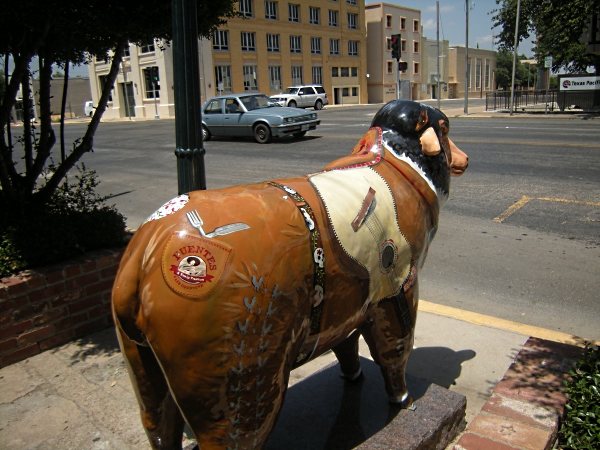
After lunch we looked at the Tom Green county courthouse, which is a boring Greek-temple looking thing, so boring that M wouldn’t waste a photograph on it, and then turned around and came home, stopping in Llano to get takeout barbecue from Cooper’s (warning: music plays) to bring home with us because L really likes Cooper’s but it was too early for us to eat when we got there.
















